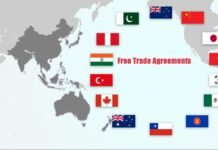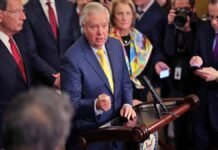
Key Points
- WTO projects global merchandise trade will decline by 0.2% in 2025, reversing earlier growth forecasts.
- If the US enforces its toughest reciprocal tariffs, the decline could deepen to 1.5%.
- North America will be hardest hit, with exports expected to fall 12.6% and imports by 9.6%.
- US tariffs on China have soared to 145%, with new duties also imposed on Canada and Mexico.
- Services trade is expected to grow by 4%, but at a slower pace due to spillover from goods trade disruptions.
- Least-developed countries are especially vulnerable to the trade slowdown and policy uncertainty.
- WTO warns that persistent trade policy uncertainty could have severe negative consequences for global growth, especially for weaker economies.
Geneva: The World Trade Organization (WTO) has sharply downgraded its outlook for global trade in 2025, citing the escalating tariff war waged by US President Donald Trump and deepening deadlock with China. According to the WTO’s latest Global Trade Outlook, world merchandise trade is now expected to contract by 0.2% this year a dramatic reversal from the 2.9% growth seen in 2024 and well below earlier forecasts of continued expansion.
North America to Bear the Brunt
The WTO report highlights that North America will experience the steepest decline, with exports forecast to plummet by 12.6% and imports by 9.6% in 2025. This regional downturn alone is expected to subtract 1.7 percentage points from global trade growth, tipping the overall figure into negative territory. Asia and Europe, by contrast, are projected to see modest gains, with Asia’s exports expected to grow by 1.6% and Europe’s by 1.0%.
Tariff Escalation and Global Impact
The downturn is directly linked to the US’s aggressive tariff measures. President Trump has imposed a universal 10% “minimum base tariff” on all imports, with much steeper rates for key trading partners. Tariffs on Chinese goods have reached an effective rate of 145%, while Canada and Mexico now face 25% duties on most exports to the US, except for Canadian energy, which is taxed at 10%. These moves have triggered swift retaliatory tariffs from China, Canada, and Mexico, further disrupting global supply chains.
“Our simulations show that trade policy uncertainty has a significant dampening effect on trade flows, reducing exports and weakening economic activity,” said WTO chief economist Ralph Ossa.
The WTO warns that if the US reactivates its toughest “reciprocal” tariffs after the current 90-day suspension, global trade could contract by as much as 1.5% this year. This would mark one of the sharpest declines in recent decades, with global GDP growth potentially falling to just 1.7%—well below the 2.8% previously forecast.
Services Trade and Vulnerable Economies
While merchandise trade is set to shrink, global services trade is projected to grow by 4% in 2025. However, this is slower than anticipated, as disruptions in goods trade spill over into sectors like transport, logistics, and travel. The WTO notes that least-developed countries (LDCs) are particularly exposed, as their economies are less diversified and more dependent on exports.
US-China Decoupling: A Major Concern
WTO Director-General Ngozi Okonjo-Iweala described the ongoing decoupling between the US and China as “really worrying,” noting that merchandise trade between the two economies is forecast to fall by up to 81% a shift with far-reaching consequences for global supply chains and economic stability.
Outlook and Risks
The WTO’s report underscores the risks posed by ongoing trade policy volatility. The organization warns that persistent uncertainty and retaliatory tariff measures could further dampen business confidence, reduce investment, and threaten the stability of the global trading system.
“The enduring uncertainty threatens to act as a brake on global growth, with severe negative consequences for the world, particularly for the most vulnerable economies,” said WTO Director-General Ngozi Okonjo-Iweala.
The WTO’s latest forecast signals a challenging year ahead for global trade, with North America facing the sharpest declines and the world economy at risk of deeper contraction if tariff tensions escalate further. The organization urges greater international cooperation to counter rising economic vulnerabilities and avoid a prolonged global slowdown.











































